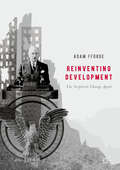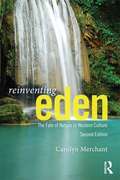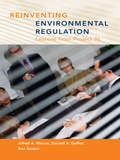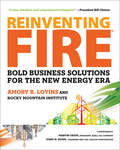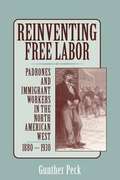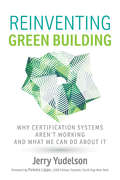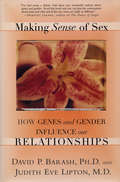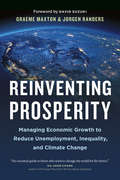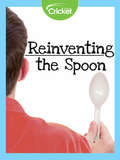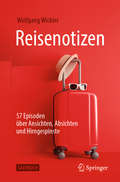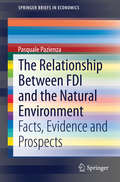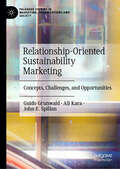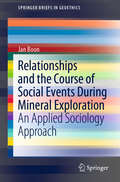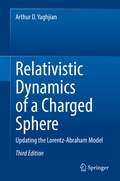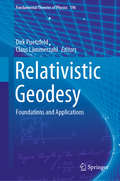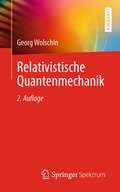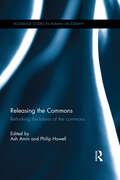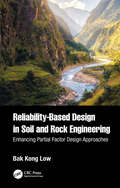- Table View
- List View
Reinigungsverfahren für Grubenwasser
by Christian WolkersdorferDieses Buch begleitet Sie auf einer Reise, die bei den Grundlagen von Grubenwasser beginnt und Sie weiter über die korrekte Probenahme für eine Planung bis hin zu den aktiven und passiven Reinigungssystemen führt. In den jeweiligen Kapiteln erfahren Sie die wichtigsten Techniken über die zu messenden Parameter (z.B. Vor-Ort-Parameter, Durchfluss), welche Methoden es gibt, um Ihr Grubenwasser aktiv zu reinigen (z.B. Dickschlammmethode, Umkehrosmose, Ionenaustausch) und welche, um eine passive Reinigung (z.B. konstruierte Feuchtgebiete, Vertikaldurchflussreaktor, Carbonatkanal) durchzuführen. Auch bekommen Sie einen Einblick in die Nutzung von Grubenwasser. Erwarten Sie kein Kochbuch – vielmehr ist es eine Zutaten- und Utensilienliste, die Ihnen dabei hilft, das richtige Rezept zu finden. Eine erweiterte Hilfe dazu erhalten Sie durch die nahezu 1000 Referenzen zu allen vorgestellten Techniken. Ich habe dieses Buch für Hydrogeologen, Ingenieure, Graduierte in höheren Semestern, Behördenvertreter, Bergleute, Geoökologen, Chemieingenieure – im weitesten Sinne also für Sie geschrieben.
Reintroducing Macroeconomics: A Critical Approach
by Steven Mark CohnThis lively introduction to heterodox economics provides a balanced critique of the standard introductory macroeconomic curriculum. In clear and accessible prose, it explains many of the key principles that underlie a variety of alternative theoretical perspectives (including institutionalist economics, radical economics, Post Keynesian economics, feminist economics, ecological economics, Marxist economics, social economics, and socioeconomics). Because the book's structure parallels the chapters and subject matter presented in a typical introductory macroeconomics textbook, "Reintroducing Macroeconomics" provides readers with a running commentary on the standard approach, while simultaneously introducing them to a broader range of ideas about the causes and appropriate policy responses to a wide range of common economic problems. Although designed primarily as a companion volume for students in introductory economics courses, the book can also be used effectively for more targeted applications that highlight a particular economic issue or approach. It will be of particular interest to students in related disciplines (such as American Studies, anthropology, black studies, environmental studies, gender studies, history, political science, and sociology) who may be required to take introductory economics classes and who are interested in gaining an alternative perspective. By demonstrating the vitality and common ground underlying a broad spectrum of heterodox approaches, "Reintroducing Macroeconomics" brings alternative perspectives into the classroom in an accessible way that empowers students to think about the economy in new and exciting ways. The text includes end-of-chapter study questions, as well as a detailed note to instructors.
Reintroducing Materials for Sustainable Design: Design Process and Educational Practice
by Mette Bak-AndersenReintroducing Materials for Sustainable Design provides instrumental theory and practical guidance to bring materials back into a central role in the design process and education. To create designs that are sustainable and respond to current environmental, economic and cultural concerns, practitioners and educators require a clear framework for materials use in design and product manufacturing. While much has been written about sustainable design over the last two decades, outlining systems of sustainability and product criteria, to design for material circularity requires a detailed understanding of the physical matter that constitutes products. Designers must not just know of materials but know how to manipulate them and work with them creatively. This book responds to the gap by offering a way to acquire the material knowledge necessary to design physical objects for sustainability. It reinforces the key role and responsibility of designers and encourages designers to take back control over the ideation and manufacturing process. Finally, it discusses the educational practice involved and the potential implications for design education following implementation, addressing didactics, facilities and expertise. This guide is a must-read for designers, educators and researchers engaged in sustainable product design and materials.
Reinventing Development
by Adam FfordeThis book debunks the foundations of contemporary government-led development policy. The author questions the predictability of success when using mainstream development doctrines and its underlying assumptions, approaching development from a sceptical standpoint, as opposed to the more common optimistic view. The book uses international development and aid as a case study of how rich countries define how change should happen. Further, it suggests alternative ways of thinking about and organizing social change.
Reinventing Eden: The Fate of Nature in Western Culture
by Carolyn MerchantThis revised edition of Carolyn Merchant’s classic Reinventing Eden has been updated with a new foreword and afterword. Visionary quests to return to the Garden of Eden have shaped Western Culture. This book traces the idea of rebuilding the primeval garden from its origins to its latest incarnations and offers a bold new way to think about the earth.
Reinventing Environmental Regulation: Lessons from Project XL
by Alfred A. Marcus Donald A. Geffen Ken Professor SextonProject XL (eXcellence and Leadership) was the flagship effort by the Clinton administration for 'cleaner, cheaper, and smarter' regulation. Under Project XL, business promised better performance in exchange for a regulatory approach focused more on results than means, with the Environmental Protection Agency (EPA) measuring pollution reduction across rather than at individual sources within a facility. Reinventing Environmental Regulation is a compelling account of the breakdown in negotiations to implement Project XL at a tape manufacturing plant of 3M, a company widely recognized as environmentally progressive. Marcus, Geffen, and Sexton discuss the conflicting goals of participants, the influences of personality and organizational culture, and complications caused by changes in 3M‘s external business environment. They compare the 3M case with EPA negotiations involving Intel, Merck, and Weyerhaeuser, finding similarly contentious, though less fatal disagreements about the meaning of 'superior environmental performance.' In common with other recent proposals, Project XL emphasized cooperative, flexible regulatory approaches. Reinventing Environmental Regulation demonstrates the difficulty of putting these appealing ideas into practice, while offering encouragement for continued innovations.
Reinventing Fire: Bold Business Solutions for the New Energy Era
by null Amory LovinsOil and coal have built our civilization, created our wealth, and enriched the lives of billions. Yet, their rising costs to our security, economy, health, and environment now outweigh their benefits. Moreover, that long-awaited energy tipping point—where alternatives work better than oil and coal and compete purely on cost—is no longer decades in the future. It is here and now. And it is the fulcrum of economic transformation.A global clean-energy race has emerged with astounding speed. The ability to operate without fossil fuels will define winners and losers in business—and among nations.In Reinventing Fire, Amory Lovins and Rocky Mountain Institute offer a new vision to revitalize business models, end-run Washington gridlock, and win the clean-energy race—not forced by public policy but led by business for enduring profit. This groundbreaking roadmap reveals market-based solutions across the transportation, building, industry, and electricity sectors. It highlights pathways and competitive strategies for a 158%-bigger 2050 U.S. economy that needs no oil, no coal, no nuclear energy, one-third less natural gas, and no new inventions.This transition would cost $5 trillion less than business-as-usual—without counting fossil fuels&’ huge hidden costs. It requires no new federal taxes, subsidies, mandates, or laws. The policy innovations needed to unlock and speed it need no Act of Congress.Whether you care most about profits and jobs, national security, health, or environmental stewardship, Reinventing Fire charts a pragmatic course that makes sense and makes money. With clarity and mastery, Lovins and RMI point out the astounding opportunities for enterprises to create the new energy era.Drawing praise from President Bill Clinton, former National Security Advisor Robert McFarlane, and a host of others, Reinventing Fire has piqued the interest of world leaders, business leaders, and political strategists.
Reinventing Free Labor: Padrones and Immigrant Workers in the North American West, 1880-1930
by Gunther PeckOne of the most infamous villains in North America during the Progressive Era was the padrone, a mafia-like immigrant boss who allegedly enslaved his compatriots and kept them uncivilized, unmanly, and unfree. In this first-ever history of the padrone, Gunther Peck argues that they were not primitive men but rather thoroughly modern entrepreneurs who used corporations, the labor contract, and the right to quit to create far-flung coercive networks. Drawing on Greek, Spanish, and Italian language sources, Peck analyzes how immigrant workers emancipated themselves using the tools of padrone power to their own advantage.
Reinventing green building
by Jerry YudelsonBuildings and their associated systems are the largest source of greenhouse gases in the world. The 2030 Challenge aims to produce zero net -energy from new North American construction by 2030 while achieving a 50% reduction in carbon emissions from existing buildings. With less than 4% of commercial and residential structures in the U. S. and Canada certified by 2015, we seem destined to fall catastrophically short of this target. Reinventing Green Building combines a unique, insider's critique of the current state of affairs with a potent vision for the future. This highly visual, data-driven analysis brings together the wisdom of today's leading practitioners including: Up-to-date information on green building issues, energy economics and new technology Dramatic new approaches to certification system design and user experience Creative, outside-the-box solutions using the Internet of Things, big data analytics and cloud-based technologies for building management. The green building revolution has failed to fulfill its promise to transform the marketplace in a meaningful way. Smart, simple, and sustainable: Reinventing Green Building presents a new approach to building certification, designed to radically cut costs while dramatically increasing marketplace acceptance integrating true climate mitigation and better building performance.
Reinventing Nature?: Responses To Postmodern Deconstruction
by Gary Paul Nabhan Albert Borgmann Michael E. Soulé Kathryn Hayles Gary Lease Alan GussowHow much of science is culturally constructed? How much depends on language and metaphor? How do our ideas about nature connect with reality? Can nature be "reinvented" through theme parks and malls, or through restoration?Reinventing Nature? is an interdisciplinary investigation of how perceptions and conceptions of nature affect both the individual experience and society's management of nature. Leading thinkers from a variety of fields -- philosophy, psychology, sociology, public policy, forestry, and others -- address the conflict between perception and reality of nature, each from a different perspective. The editors of the volume provide an insightful introductory chapter that places the book in the context of contemporary debates and a concluding chapter that brings together themes and draws conclusions from the dialogue.In addition to the editors, contributors include Albert Borgmann, David Graber, N. Katherine Hayles, Stephen R. Kellert, Gary P. Nabhan, Paul Shepard, and Donald Worster.
Reinventing Prosperity: Managing Economic Growth to Reduce Unemployment, Inequality, and Climate Change
by Graeme Maxton Jorgen Randers&“An important contribution to the global debate about growth, equality, climate change, and the path to a viable human future.&” —David Korten, international bestselling author of When Corporations Rule the World The biggest challenges facing human wellbeing today—widening income inequality, continuing global poverty, and environmental degradation—may be simple to solve in theory. But, because we are required to come up with solutions that are acceptable to a political majority in the rich world, they are much harder to solve in practice. Most of the commonly proposed &“solutions&” are simply not acceptable to most people. Many of these proposed solutions—like stopping the use of fossil fuels—require a sacrifice today in order to obtain an uncertain advantage in the far future. Therefore they are politically infeasible in the modern world, which is marked by relatively short term thinking. In Reinventing Prosperity, Graeme Maxton and Jorgen Randers provide a new approach altogether through thirteen recommendations which are both politically acceptable and which can be implemented in the current period of slow economic growth around the world. Reinventing Prosperity solves the forty-year-old growth/no-growth standoff, by providing a solution to income inequality, continuing global poverty and climate change, a solution that will provide for economic growth but with a declining ecological footprint.Reinventing Prosperity shows us how to live better on our finite planet—and in ways we can agree on. &“An essential guide to those who want to change the world for the better—and for certain.&” —Ha-Joon Chang, international bestselling author of 23 Things They Don&’t Tell You About Capitalism &“[A] well-argued book . . . explaining complex issues in a style that is clear, logical, and succinct.&” —Publishers Weekly
Reinventing the Spoon
by Cricket MediaThe Bakeys company uses a simple recipe to make edible spoons in the hopes of cutting down on plastic trash.
The Reinvention of Mexico in Contemporary Spanish Travel Writing
by Jane HanleyThe long history of transatlantic movement in the Spanish-speaking world has had a significant impact on present-day concepts of Mexico and the implications of representing Mexico and Latin America more generally in Spain, Europe, and throughout the world. In addition to analyzing texts that have received little to no critical attention, this book examines the connections between contemporary travel, including the local dynamics of encounters and the global circulation of information, and the significant influence of the history of exchange between Spain and Mexico in the construction of existing ideas of place. To frame the analysis of contemporary travel writing, author Jane Hanley examines key moments in the history of Mexican-Spanish relations, including the origins of narratives regarding Spaniards' sense of Mexico's similarity to and difference from Spain. This history underpins the discussion of the role of Spanish travelers in their encounters with Mexican peoples and places and their reflection on their own role as communicators of cultural meaning and participants in the tourist economy with its impact—both negative and positive—on places.
Reisenotizen: 57 Episoden über Ansichten, Absichten und Hirngespinste
by Wolfgang WicklerEin Buch für neugierige Leser. Geschildert werden im Laufe von 60 Jahren angehäufte Erlebnisse des forschenden Autors auf allen Kontinenten und dadurch ausgelöste Nachgedanken über die Fortpflanzung der Lebewesen, kulturelle Praktiken, kuriose Traditionen, gepflegte Irrtümer und unzumutbare Glaubensinhalte. Jede harmoniesüchtige Weltanschauung kontrastiert mit der auf Konkurrenz und Konflikt angelegten Schöpfung und führt zu negativ nachhaltigem technischem und religiösem Missionieren. Stimmt es, dass der Mensch aus Erfahrung lernt?
Relational and Critical Perspectives on Education for Sustainable Development: Belonging and Sensing in a Vanishing World (Sustainable Development Goals Series)
by Margaretha Häggström Catarina SchmidtThis volume focuses on the fourth Sustainable Development Goal (SDG), education, to look at sustainability from various angles with the purpose of challenging preconceptions about what sustainable education might entail and how it should be conducted. To this end, the book assembles scholars from various research fields and disciplines, who are willing to be at the cutting edge regarding sustainability and education on all levels with students in the ages of 6-15. Through this approach, the text points towards a “wild pedagogy” in line with post-sustainable thinking. This involves agency and the role of nature itself as a co-educator, and promotes cultural changes, and explorative processes of finding “the wild” – the unknown, and complexity in nature – and thus of challenging the human need for control. This approach is also, in line with the 2030 Agenda, an attempt to move from advocating predetermined behavioural change to embracing a pluralistic perspective on sustainability, based on holistic views on education. Such views include curiosity, wonderment, compassion and agency as guiding lights. The book is structured into three sections, based on three interrelated strands. These strands are, in various ways, dependent on one another and further engaged with bringing education theory and practice together. These strands are 1) Belonging and sensing, 2) Critical thinking, social justice and action competence, and 3) Creating hope in a vanishing world. These strands aim to increase our access to and understanding of the ways in which sustainability can be integrated into education and why. The purpose of the text is to encourage educators of all kinds and levels, as well as scholars in different fields, to explore new perspectives on education for sustainable development. The book examines probes in diverse academic fields and focuses on how to combine different approaches and content, and therefore everyone interested in interdisciplinary and cross-curricular teaching and learning should find this work enlightening.
The Relationship Between FDI and the Natural Environment
by Pasquale PazienzaThis work examines in depth the relationship between foreign direct investment and the environment. Over the last few decades, increasing levels of environmental degradation have been recorded and have been claimed to be particularly attributable to globalization and the widespread increase of economic activities, in particular foreign direct investments (FDIs). However, the environmental implications of FDIs are not easily identified and contradictory views and arguments have been presented. This work contributes to the debate by closely analyzing the specific literature produced over the last three decades, and by presenting and discussing recent trends and prospects with regard to the FDI phenomenon.
Relationship-Oriented Sustainability Marketing: Concepts, Challenges, and Opportunities (Palgrave Studies in Marketing, Organizations and Society)
by John E. Spillan Guido Grunwald Ali KaraThis book explores sustainability marketing through the lens of stakeholder relationship-related concepts, with a particular focus on stakeholders within global value chains, relationships with the public, and those affiliated with governmental entities. Addressing a perceived gap in the current literature, the chapters delineate contemporary challenges and propose potential solutions for each stakeholder group, prioritizing the strategic and cross-instrumental dimensions. Offering a comprehensive examination of relationship-oriented sustainability marketing in the contemporary landscape, this work will acquaint researchers with the challenges related to stakeholder engagement in sustainability marketing and advance scholarship on effectively managing stakeholder relationships.
Relationships and the Course of Social Events During Mineral Exploration: An Applied Sociology Approach (SpringerBriefs in Geoethics)
by Jan BoonThis book provides the results of nine case studies of the course of social events in mineral exploration projects (mostly in Latin America). The author concluded that, while each case is sui generis, the underlying sociological processes are the same. This made it possible to develop a generalized model for the course of social events during mineral exploration. It consists of seven stages: (i) arrival of the project; (ii) initial meanings, interpretations and decisions; (iii) real dialogue; (iv) building relationships; (v) change processes; (vi) new relationships and social structures and (vii) the course of social events and perceived benefits and harms. Stages (iii) => (iv) => (v) => (iii) form a continuous iterative cycle. Dialogue and relationships are at the heart of the model. The text describes five of the nine case studies in some detail and illustrates how sociology explains the sociological processes in these projects. These examples, together with the final chapter that discusses the implications, provide many practical pointers for all actors involved: industry, communities, NGOs, home governments and host governments.
Relative Fidelity Processing of Seismic Data: Methods and Applications
by Xiwen WangThis book presents a comprehensive overview of relative fidelity preservation processing methods and their applications within the oil and gas sector. Four key principles for wide-frequency relative fidelity preservation processing are illustrated throughout the text. Seismic broadband acquisition is the basis for relative fidelity preservation processing and the influence of seismic acquisition on data processing is also analyzed. The methods and principles of Kirchhoff integral migration, one-way wave equation migration and reverse time migration are also introduced and illustrated clearly. Current research of relative amplitude preservation migration algorithms is introduced, and the corresponding numerical results are also shown. RTM (reverse time migration) imaging methods based on GPU/CPU systems for complicated structures are represented. This includes GPU/CPU high performance calculations and its application to seismic exploration, two-way wave extrapolation operator and boundary conditions, imaging conditions and low frequency noise attenuation, and GPU/CPU system based RTM imaging algorithms. Migration velocity model building methods in depth domain for complicated structures are illustrated in this book. The research status and development of velocity model building are introduced. And the impacting factors are also discussed. Several different velocity model building methods are also represented and analyzed. The book also provides the reader with several case studies of field seismic data imaging in different kinds of basins to show the methods used in practice.
Relativistic Dynamics of a Charged Sphere: Updating the Lorentz-Abraham Model
by Arthur D. YaghjianIn addition to expanding and clarifying a number of sections of the first edition, it generalizes the analysis that eliminates the noncausal pre-acceleration so that it applies to removing any pre-deceleration as well. It also introduces a robust power series solution to the equation of motion that produces an extremely accurate solution to problems such as the motion of electrons in uniform magnetic fields.
Relativistic Fluid Dynamics In and Out of Equilibrium: And Applications to Relativistic Nuclear Collisions (Cambridge Monographs on Mathematical Physics)
by Paul Romatschke Ulrike RomatschkeThe past decade has seen unprecedented developments in the understanding of relativistic fluid dynamics in and out of equilibrium, with connections to astrophysics, cosmology, string theory, quantum information, nuclear physics and condensed matter physics. Romatschke and Romatschke offer a powerful new framework for fluid dynamics, exploring its connections to kinetic theory, gauge/gravity duality and thermal quantum field theory. Numerical algorithms to solve the equations of motion of relativistic dissipative fluid dynamics as well as applications to various systems are discussed. In particular, the book contains a comprehensive review of the theory background necessary to apply fluid dynamics to simulate relativistic nuclear collisions, including comparisons of fluid simulation results to experimental data for relativistic lead-lead, proton-lead and proton-proton collisions at the Large Hadron Collider (LHC). The book is an excellent resource for students and researchers working in nuclear physics, astrophysics, cosmology, quantum many-body systems and string theory.
Relativistic Geodesy: Foundations and Applications (Fundamental Theories of Physics #196)
by Dirk Puetzfeld Claus LämmerzahlDue to steadily improving experimental accuracy, relativistic concepts – based on Einstein’s theory of Special and General Relativity – are playing an increasingly important role in modern geodesy. This book offers an introduction to the emerging field of relativistic geodesy, and covers topics ranging from the description of clocks and test bodies, to time and frequency measurements, to current and future observations. Emphasis is placed on geodetically relevant definitions and fundamental methods in the context of Einstein’s theory (e.g. the role of observers, use of clocks, definition of reference systems and the geoid, use of relativistic approximation schemes). Further, the applications discussed range from chronometric and gradiometric determinations of the gravitational field, to the latest (satellite) experiments. The impact of choices made at a fundamental theoretical level on the interpretation of measurements and the planning of future experiments is also highlighted. Providing an up-to-the-minute status report on the respective topics discussed, the book will not only benefit experts, but will also serve as a guide for students with a background in either geodesy or gravitational physics who are interested in entering and exploring this emerging field.
Relativistische Quantenmechanik
by Georg WolschinDieses Buch richtet sich an Studierende der Physik, die bereits über Grundkenntnisse der Quantenmechanik verfügen und relativistische Wellengleichungen kennenlernen möchten. Im Hauptteil des Buchs behandelt der Autor die Klein-Gordon-Gleichung und die Dirac-Gleichung, wobei er deren Lösungen und ihre Bedeutung hervorhebt. Die Invarianzen der Dirac-Gleichung in Bezug auf Paritätstransformation, Ladungskonjugation und Zeitumkehr werden diskutiert, mit dem Klein’schen Paradoxon wird dem Leser eine interessante Anwendung näher gebracht und mit der Weyl-Gleichung ihr Spezialfall für masselose Fermionen dargestellt. Neben diesen Schwerpunkten werden die Entwicklungen thematisiert, die zur Aufstellung der relativistischen Wellengleichungen durch Schrödinger, Klein, Gordon und Dirac führten und somit auch auf den wissenschaftshistorisch interessanten Hintergrund verweisen. Ebenfalls erläutert ist die Verbindung zur Galilei-invarianten nicht-relativistischen Quantenmechanik. Zuletzt werden kurz die Grundzüge der Quantenelektrodynamik und Elemente der relativistischen Streutheorie erläutert.Anhand von Testaufgaben am Ende des Buchs wird der Leser dazu motiviert, den Stoff selbst beispielhaft nachzurechnen und das Gelernte zu festigen. Die Mehrzahl der Lösungen lassen sich im jeweiligen Kapitel finden.Die vorliegende zweite Auflage wurde vollständig durchgesehen, an vielen Stellen verbessert, ergänzt und überarbeitet. Ein neues Schlusskapitel über relativistische Schwerionenkollisionen wurde hinzugefügt.
Releasing the Commons: Rethinking the futures of the commons (Routledge Studies in Human Geography)
by Ash Amin and Philip HowellThis book moves beyond seeing the commons in the past tense, an entity passed over from the public into the private, to reimagine the commons as a process, a contest of force, a reconstitution, and a site of convening practices. It highlights new spaces of gathering opening up, such as the digital commons, and new practices of being in common, such as community economies and solidarity networks. The commons is seen as a contested domain of the collective and as a changing way of being in common, with the balance poised in the tensile play between political economy and social innovation. The book focuses on the possibility of recovering a future in which more can be held by the many, focusing on three concepts: nation and nature as a commons, publics and rights, and bodies, concerning the management of lives and livelihoods. Across these three passage points, the book finds evidence of a commons under attack but also defended in fragile though promising ways. With contributions from leading scholars, this thought provoking book will be of great interest to students and scholars in geography, environmental studies, politics, anthropology, and cultural studies.
Reliability-Based Design in Soil and Rock Engineering: Enhancing Partial Factor Design Approaches
by Bak Kong LowThis book contains probabilistic analyses and reliability-based designs (RBDs) for the enhancement of Eurocode 7 (EC7) and load and resistance factor design (LRFD) methods. An intuitive perspective and efficient computational procedure for the first-order reliability method (FORM, which includes the Hasofer–Lind reliability index) is explained, together with discussions on the similarities and differences between the design point of EC7/LRFD and RBD-via-FORM. Probability-based designs with respect to the ultimate and serviceability limit states are demonstrated for soil and rock engineering, including shallow and deep foundations, earth-retaining structures, soil slopes, 2D rock slopes with discontinuities, 3D rock slopes with wedge mechanisms, and underground rock excavations. Renowned cases in soil and rock engineering are analyzed both deterministically and probabilistically, and comparisons are made with other probabilistic methods. This book is ideal for practitioners, graduate students and researchers and all who want to deepen their understanding of geotechnical RBD accounting for uncertainty and overcome some limitations and potential pitfalls of the evolving LRFD and EC7. Solutions for the book’s examples are available online and are helpful to acquire a hands-on appreciation: https://www.routledge.com/9780367631390.



